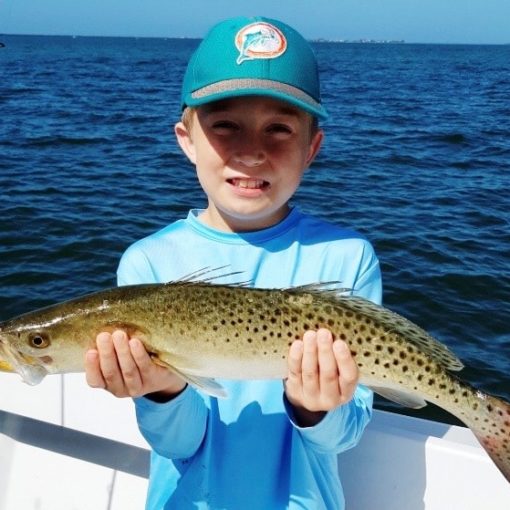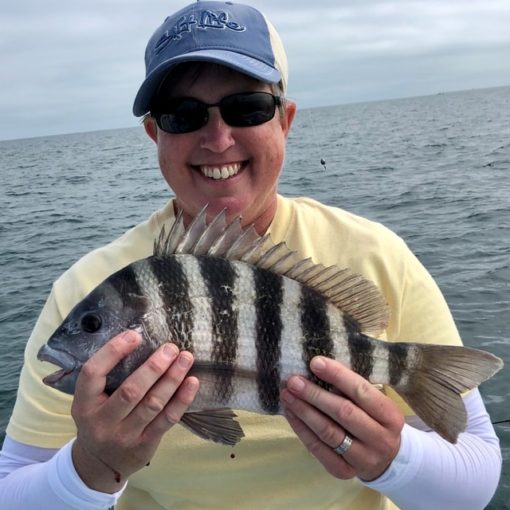If you’ve been out and about on our beautiful Cape Coral waters, you may have seen a fish floating around on its side near the surface. This is Lobotes surinamensis, an average sized marine fish that lives in warm tropical waters around the world. However, it is the only member of this family found in the Atlantic Ocean and Gulf of Mexico. You may know this floating flotsam-like fish by its more common name tripletail, or Atlantic tripletail. If you haven’t seen one and would like to, contact us for the best fishing charters in Cape Coral.
When A Tripletail Doesn’t Have A Triple Tail
The aptly named tripletail gets its name from the unusual configuration of its dorsal, caudal and anal fins. The rounded dorsal and anal fins are located at the rear of the fish’s body, close to the similarly rounded caudal fin. This gives the appearance of a triple or three-lobed tail.
Identifying Tripletail
Tripletails are a very distinctive fish, not easily confused with other species. First, they have those distinctive fins we mentioned above. Then there is their unusual habit of lying on their sides! Structurally they’re also distinctive with a very deep, narrow body, large mouth and small eyes set forward on the head.
Their coloring likewise is unusual. Notably, they can change color to blend in with their surroundings! As juveniles, tripletails are a mottled black, brown and yellow with white edging on the caudal fin and white pectoral fins. At this age, they are usually found living in and under Sargassum algae patches where this coloring provides the perfect camouflage.
With adults there is a range of colorations due to that ability to change color. Typically though they’re much darker than juveniles with black or dark brown mottling and a hint of grey. This gives rise to some of tripletail’s other common names, including blackfish and black perch.
Adult tripletails can reach 35 inches in length, at which point they’ll usually weigh around 41 pounds. They are excellent jumpers; many have escaped an uncertain fate by jumping out of boats after capture! Unfortunately, their habit of lying on their sides close to the surface makes them easy pickings for sight-fishing. This has led to overfishing in some parts of the Gulf. For this reason most Gulf states now have strict bag limits for recreational fishing. Arrange to come tripletail fishing in Cape Coral with us and we’ll make sure you don’t fall foul of Florida’s tripletail bag and size limits.
Finding Tripletail
Tripletail are endemic to tropical marine waters around the world. They are a seasonal semi-migratory species with a narrow tolerance range for water temperature so must seek out warmer waters in winter. In the US, their range goes as far north as Massachusetts along the Atlantic coast. In summer, it’s common to see them along our Gulf coast here in Florida. Notably, they have 2 favorite spring gathering spots in the Gulf. One is just off Cape Canaveral. The other is off Jekyll Island in Georgia.
Whilst adult tripletail normally live solitary lives, they can also form large schools. In the Gulf, they’re often spotted in open water but we’ve also found them closer inshore. They particularly like our bays, inlets, and river mouths. However, they’re not euryhaline so must remain within a specific salinity range. You may also see them near the surface out in deeper water hanging around floating objects.
Spawning Habits
Tripletail are summer spawners, with peak spawning happening over July and August. Their preferred US spawning grounds are along the Gulf and southern US Atlantic coastlines. We mentioned their habit of gathering off Cape Canaveral and Jekyll Island during summer earlier. There’s a good reason for this. It seems this particular part of the Gulf coastline is an extremely important estuarine spawning ground for tripletail.
Surprisingly not much is known about their actual spawning habits, particularly here in the Gulf. It’s thought they are likely deepwater aggregate spawners but research is ongoing into this. Certainly tripletail larvae and tiny juveniles are rarely if ever found in nearshore or shallow water. It does also seem that mature females can spawn between 18 and 30 times each season, releasing a total of some 4–8 million eggs.
We further know that once the eggs hatch, the larvae go through 4 stages of development. At around a 16th of an inch they already have distinctive eyes and a concave head. By the time they’re just over half an inch long, they’ve transitioned from larval to juvenile stage. The tiny little tripletails eventually make their way to handy algae patches and other shaded areas. They’ll live and hide in these protective ‘nurseries’ until old enough to venture out into open water.
Unusual Feeding Habits
Tripletail are ambush predators. That habit of floating on their sides looking like a piece of flotsam seems to have at least one sinister motive. It allows them to ‘lie around’ cleverly disguised and wait for prey to unwittingly venture too close. When it does, the fish pounces… Tripletail predominantly eat other smaller fish species and bottom dwelling crustaceans like shrimp and squid. They themselves fall prey to larger fish like sharks.
The Best Tripletail Fishing Charters
Book your custom tripletail fishing trip through Blue Line LLC. We take care of all the paperwork, including required permits and licences. All you have to do is turn up, sit back, and relax whilst we take you to the best local fishing spots.





